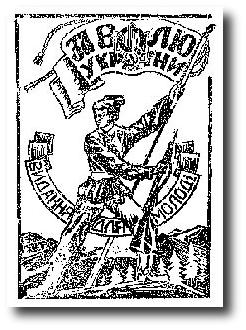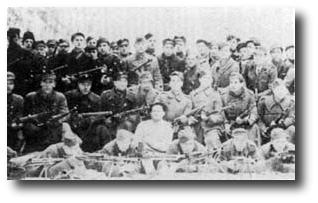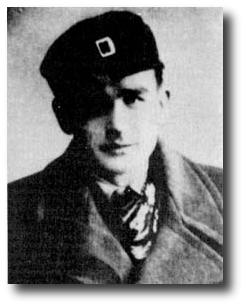![[LITOPYS UPA: Chronicle of the Ukrainian Insurgent Army]](/upa/images/litopys.jpg)
SERIES 1
VOLUME 19
![[LITOPYS UPA: Chronicle of the Ukrainian Insurgent Army]](/upa/images/litopys.jpg)

 The materials published in Volume 19 of Litopys UPA are organized into
four chapters: reports and sketches by the commander of the UPA's
Military District (VO) IV, UPA-West, Lt. Ivan Butkowskyi,
recollections of "Chornyi Lis" soldiers, memoirs published by the
underground and the reminiscences of a Dutch general.
The materials published in Volume 19 of Litopys UPA are organized into
four chapters: reports and sketches by the commander of the UPA's
Military District (VO) IV, UPA-West, Lt. Ivan Butkowskyi,
recollections of "Chornyi Lis" soldiers, memoirs published by the
underground and the reminiscences of a Dutch general.
The first chapter consists of three articles by Ivan Butkovskyi. Butkovskyi (a former company commander in the Carpathian Sich) joined the UPA in November, 1943 (he was seriously wounded on November 27). Around the beginning of 1944, he took over the command of the Military District IV, UPA-West, and was promoted to the rank of First Lieutenant. He remained at this post until July, 1944, and then he was sent abroad, where he fulfilled the duties of Chief of the UPA Mission with the Foreign Representation of the Supreme Ukrainian Liberation Council (ZP UHVR). In 1950, he was promoted to the rank of UPA Lieutenant Colonel. His sketch, "A Year of Struggle by the UNS-UPA for Control of the Carpathians", provides general information about the beginnings of the UPA in the Stanyslaviv (and to some extent Drohobych) oblast and the major battles and skirmishes which took place in these regions.
The next article is an excerpt from a report about UPA battles with Red partisans for control of the Chornyi Lis (Black Forest) between April 23 and June 4, 1944. Taking part in these encounters were the companies commanded by "Rizun", "Hamaliya", "Blahyi" and "Chernyk", which were under the general command of Second Lieutenant Vasyl Andrusiak - "Rizun". The last article is also an excerpt from a report, about encounters of UPA units with Germans and Hungarians from July 6 to July 15, 1944 in the Dolyna region. Described here is the July 8 encounter on Lopata Mountain, where the battalion commanded by Second Lieutenant "Rizun" was staying. The battalion was attacked by detachments from two German divisions and a regiment of Hungarians. Also mentioned here are battle actions of the officers' school battalion and the companies "Zahrava", "Zhuravli' and "Haidamaky".
The second chapter includes the recollections of five soldiers from the Stanyslaviv Tactical Sector (TV) 22, "Chornyi Lis", which was commanded by Major (posthumously Colonel) Vasyl Andrusiak-"Rizun"-"Hrehit". The first memoir was written by Corporal Ivan Morkovchuk-"Chubenko", squad leader in the company commanded by "Hamaliya" (later commanded by "Pyrih"). The author of the second memoir, Staff Sergeant Ivan Bohuslavskyi-"Spivak", was Chief medic orderly in the company commanded by "Rizun" (later commanded by "Prut", then by "Sokil"). These two memoirs describe events in which the companies of the battalion commanded by "Rizun " took part (the battalion was later called "Pidkarpatskyi" and was commanded by "Prut") from the summer of 1944 to November 1945. The memoirs were written after the authors got to the West, in October 1947. The third memoir was written in 1932 by Hryhoriy Kostiuk-"Nezlomnyi" and describes life in the "Pidkarpatskyi" battalion from April to August 1945. The author dwells in particular on the battalion's raid through the Drohobych oblast (May-July 1945) and gives descriptions of commanders.
The memoir of Staff Sergeant Mykola Lytvynets-"Komar" is actually an official report from 1948, which gives the author's observations from his involvement in the UPA from July 1943 - August, 1947. "Komar" was first in the training battalion "Chorni Chorty" in the Kolomyia region; in November, 1943, he was transferred to the Chornyi Lis, to the company commanded by "Rizun", and from March, 1945, he was in the "Dzvony" battalion. He speaks in particular about the major changes which took place in the command of the "Dzvony" battalion in 1945-1947.
 The last author published here is UPA Captain Volodymyr Chaviak-"Chornota",
who commanded the "Dzvony" battalion from 1945 to 1947. He
describes how he joined the UPA in July, 1943, and his training in the
"Chorni Chorty" battalion in the Kolomyia region. Later he speaks of
his transfer to the Chornyi Lis, near Stanyslaviv, where he came under
the command of "Rizun". There, in 1943-1945, he served as squad leader,
platoon leader, company commander and finally, battalion commander. In
August, 1947, battalion commander "Chornota" was ordered to lead a
courier group to the West. In Chechoslovakia, he was wounded and while
unconscious, fell into the hands of the Czech police, who turned him
over to the Soviet NKGB. He describes his imprisonment in 1948-1949,
then his stay in a concentration camp in Vorkuta. In 1957, he was
released, but he did not return permanently to his native area until
1965. His life story includes brief descriptions of persecution by the
KGB up to 1990.
The last author published here is UPA Captain Volodymyr Chaviak-"Chornota",
who commanded the "Dzvony" battalion from 1945 to 1947. He
describes how he joined the UPA in July, 1943, and his training in the
"Chorni Chorty" battalion in the Kolomyia region. Later he speaks of
his transfer to the Chornyi Lis, near Stanyslaviv, where he came under
the command of "Rizun". There, in 1943-1945, he served as squad leader,
platoon leader, company commander and finally, battalion commander. In
August, 1947, battalion commander "Chornota" was ordered to lead a
courier group to the West. In Chechoslovakia, he was wounded and while
unconscious, fell into the hands of the Czech police, who turned him
over to the Soviet NKGB. He describes his imprisonment in 1948-1949,
then his stay in a concentration camp in Vorkuta. In 1957, he was
released, but he did not return permanently to his native area until
1965. His life story includes brief descriptions of persecution by the
KGB up to 1990.
The third chapter, which is entitled "Underground Memoirs", consists of reprints of magazines, magazine articles, pamphlets about "Rizun", and excerpts from an anthology about Bukovyna.
The magazine Za voliu Ukrainy, No. 7 (October1949) was published by the Kalush Tactical Sector (TV) 23, which is why the title page mentions Zhydachiv-Dolyna-Kalush (centres of the Nadraions of the underground network of the Kalush Okruha). This magazine was an irregular publication for youth and published memoirs, historical sketches, insurgent songs and the like . Number 7 was published as pamphlets of 25 typed half-pages. Actions are described, the most active were the Security Service (SB) fighting groups. The list of those fallen in battle makes it possible for researchers to at least partially recreate the organizational structure of this territory. One of the articles describes how the company "Bystrytsia" was organized in February-March, 1945.
The irregularly-published magazine Homin voli was published in the Drohobych Tactical Sector 24. Number 3 (1950) consisted of 41 half-pages of type. It published seven short memoirs from 1944-194B. These are descriptions of engagements of UPA units, Local Self defence Units (SKV) and local fighting groups. Some of the memoirs describe actions that took place in Zakerzonnia, outside of Soviet Ukraine, in the Lemko Tactical Sector 26, from where the authors arrived in 1947. Also published here are some lists of those fallen in battle, among them, Captain "Kaidanets" and Lt. "Karmeliuk. "
Next come three articles from the booklet U borotbi za voliu -- Pid boiovymy praporamy UPA, published in 1946 in Military District VI, UPA-West (Zakerzons'kyi Krai), outside of Soviet Ukraine. The articles recount events which took place in the Hutsul region in 1945. "For Kosmach" describes two battles for the village of Kosmach, which occured on January 30 and February 3, 1945. The article gives the names of almost all of the companies in the "Karpatskyi", "Haidamaky" and "Hutsulskyi" battalions. The title of the article "After the Twentieth" refers to July 20, 1945 -- the deadline set in one of the appeals of the Soviet government to Ukrainian insurgents that they give themselves up in exchange for a full pardon. The article briefly describes the reaction to this Soviet government appeal of the company commanded by "Moroz." The third article, "Insurgent Christmas", gives a brief description of an engagement of the "Surma" company, which was commanded by "Buryi". This skirmish with a Soviet unit took place right on Christmas Day, January 7, 1945, in the Drohobych oblast.
The pamphlet entitled Colonel Hrehit-Rizun originally consisted of four half-pages of print with an artistically designed title page. It was the second publication in the series In the Footsteps of the Heroes - Series of Publication for Youth issued in 1948. The pamphlet is basically a military biography of Vasyl Andrusiak, commander of the Stanyslaviv Tactical Sector 22 - "Chornyi Lis", who, according to official information, was killed on February 24, 1946, although some memoirs and publications also give the date February 17 and February 25.
 The chapter ends with excerpts from the anthology Bukovyna v borotbi,
which give information about events in the Bukovyna Tactical Sector 20
and the Chernivtsi Region of the underground network from April 1944
to December 1946. The description of raids give a lot of information
about UPA units from other areas, in particular, "Siri Vovky" from the
Chortkiv region and "Surma" from the Kolomyia region.
The chapter ends with excerpts from the anthology Bukovyna v borotbi,
which give information about events in the Bukovyna Tactical Sector 20
and the Chernivtsi Region of the underground network from April 1944
to December 1946. The description of raids give a lot of information
about UPA units from other areas, in particular, "Siri Vovky" from the
Chortkiv region and "Surma" from the Kolomyia region.
In the last chapter we find the reminiscences of Lt General Edvard J.U. van Hotegem, former commander of a Royal Dutch Army corps. The memoir begin by describing his experiences as a German prisoner of war and his escape from the prisoner-of-war camp in the Stanyslaviv region. He recounts in detail how, in January, 1944, he and other Dutch officers from the camp were helped by the UPA. The commander of Military District IV arranged safe passage for the group of Dutch officers through the Carpathian Mountains to Hungary, from where they returned to the Netherlands after the war. These memoirs are a reprint of a booklet published by the Ob'iednannia Kolyshnikh Voiakiv UPA (Association of Former UPA Soldiers).
The materials from 1944-1950 which we are publishing in this volume were obtained from the Archive of the ZP UHVR, which was collected, organized and looked after for several decades by Mykola Lebed, General Secretary of Foreign Affairs of the Supreme Ukrainian Liberation Council.
The editor would like to thank everyone who assisted in the preparation of this volume. In particular, I thank Stepan Shpak for preparing the index, Chrystyna Sodol for preparing the photographs, Iryna Bilevych for retyping articles, Hryhoriy Kolodiy for help with the organizational diagrams, Volodymyr Makar for proofreading, Antin Ivakhniuk for editing of the introductory article and memoirs, Jurij Majiwskyj for technical advice, Mykola Kulyk for assistance with photographs and texts, and Yevhen Shtendera and the Editorial Committee for their patience.
Petro Sodol